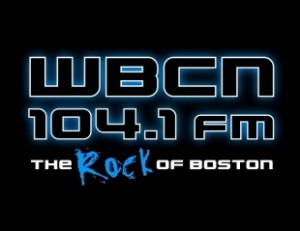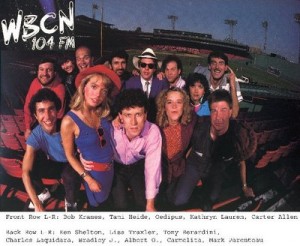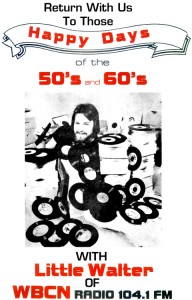When it comes to commercial radio, I’d argue that true progressive rock radio died somewhere in the early 80s, as tighter playlisting, more frequent rotations and shorter music sets became required, and DJs by-and-large no longer picked their records. Nevertheless a handfull of stations in the top major markets held onto the progressive moniker by keeping their rotations less repetitive, being a tad bit more experimental with the songs they added andretaining DJs who seem to know and care about the music, all while giving a more believable appearance of artistic integrity.
For rock music fans over the age of 30 the call letters are often drilled into memory: WNEW in New York, WMMS in Cleveland, KSAN in San Francisco, WBCN in Boston and WXRT in Chicago. At the beginning of 2009 only WBCN and WXRT remained on air in a form with any semblance to their former glory. As of last Thursday WBCN had joined the off-air list.
Well, it’s not entirely accurate to say that WBCN has gone off-air. While the station’s analog signal at 104.5 FM has been replaced with an all-sports format, the rock station has found a new home on a digital-only 98.5 FM HD channel 2 along with retaining its webcast. As recent press reports on the station’s move–which read like obituaries–tirelessly note, WBCN was the first station in the US to play a once obscure little band from Ireland called U2, along with pioneering the introduction of many former “alternative” rock bands on commercial radio, like the Red Hot Chili Peppers and Pearl Jam. Of course, the station was much more progressive during album rock’s heyday in the late 60s and early 70s, when such future rock luminaries as J. Geils Band’s Peter Wolf did DJ stints.So storied and revered is the station’s history that a feature-length documentary covering the years 1968-1975 is now in the works. The production was announced in January, some seven months before WBCN’s digital shift was announced. I wonder if the near-death of WBCN will be as advantageous for the funding of the doc as Michael Jackson’s real death was for the singer’s album sales? I use the term “near-death” even though the station remains on HD radio and online because I really wonder if that move isn’t just hospice care that allows CBS Radio to kill it more quietly while almost nobody is listening. Now, I don’t doubt that some die-hard fans will continue to listen online or go out and buy HD radios to keep their co-dependent relationship alive. But I’m not sure it’ll be enough to make a difference.
As of the third quarter of 2008 total HD radio sales totaled 600,000. Being very charitable, let’s say that even 1 million HD radios are out there by the end of this year. How many of those are in Boston, and then how many of those Boston-area HD radio owners are likely WBCN listeners?
WBCN’s winter 2008 Arbitron ratings gave the station a 2.1 share, making it 15th in the market. With a metro population of 3,912,000, that gave WBCN an average audience of 82,152. Obviously it’s not market leading, but not too shabby either.
For argument’s sake, let’s say Boston has as many as two per-cent of all HD Radios out there–making it a little more HD-radio-rich than it’s proportion of the population would suggest–and that there are as many as 800,000 HD radios in the US. Then it’s plausible that there could be 16,000 HD radios in the Boston market. Even if every single one of them is tuned to WBCN, that’s a loss of about 80% of its former analog audience.
Well, you might ask, what about the online audience? It’s a little harder to crunch the numbers since the ratings for individual stations don’t get released in any systematic fashion. The best we have right now are ratings for whole radio groups. By that measure, CBS Radio, WBCN’s owner, looks pretty good, ranking number one with a cumulative listener base of 4.4 million. But those millions of listeners are spread out over hundreds of online streaming stations. According to the company,
In addition to CBS RADIO’s nearly 200 stations and custom channels, the company also powers AOL Radio’s 200+ stations and Yahoo! Music Radio’s 150+ stations. …
Averaged out, that’s 8,000 listeners per station. Of course it’s unlikely that the distribution is anywhere near that even. Nevertheless it illustrates clearly how going online-only means a massive step down in audience size for WBCN. Since audience size determines ad dollars, it’s a pretty big revenue drop, too.
And since revenue pays for programming and air talent, I’m betting that means the digital-only WBCN will experience a loss of staff, too.
The essence of progressive rock radio was always people; passionate programmers and DJs picking music that resonates with them personally and with their audience, often interacting directly with the artists themselves, whether local or touring. I sincerely doubt that much of that essence will be retained at WBCN in the coming months and years.
Instead WBCN will become another Chrysler K-car version of rock radio. Like the K-car became a sports coupe by slapping on some fancy trim and a classic name, the digital-only WBCN becomes progressive rock by sprinkling in some of the trademark artists and leaning heavily on a storied past. Just don’t expect that strategy to work out any better for WBCN than it did for Chrysler.





